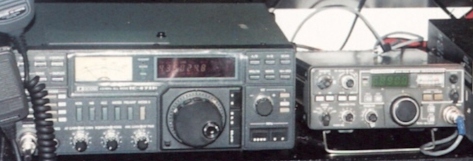On August 23, 1993 I had an amateur radio experience that sparked a new
direction for me in the hobby. I made my first contact through a satellite. The
thought of my signal going into space and coming back from a satellite to make
contact with another ham somewhere else in the world truly amazed me. My first
contact was through RS-12 on mode "K" which was 15 meters up and ten meters
down. I already had HF antennas covering these bands so this first satellite
contact required only a little time investment to understand the process.
After that first contact I was hooked! Now I wanted to work all of the satellites or birds as they are sometimes called. Upon doing some research I discovered a huge problem with this next ham radio adventure. The cost of everything I would need to readily work through any satellite I wanted was going to be much more than I could afford at the time. This inspired me to do what hams are known for in the hobby. I started sketching out designs for antenna's, GaasFet preamps, switching systems, elevation controls, power dividers, and the list goes on. I soon realized I could build an affordable homebrew satellite array.
The biggest cost was going to be a rig that put out a decent amount of power on 432mhz for an uplink transmitter as well as a downlink receiver. After a few months of searching I found a new in the box Icom IC-471 432mhz all mode that put out 75 watts. I already had a Kenwood TR-9130 2 meter all mode sitting on my desk for terrestrial use so now I was close to being in the satellite business. I built a homebrew GaasFet preamp dead bug style and installed it directly in the little Kenwood 9130 to eliminate having to build any complex switching devices. I found a new in the box Icom GaasFet 432mhz mast mounted preamp at a ham fest for $40.00. This was everything I would need for inside the shack now the only thing left to build was an antenna array.
 After about two months of building I finally had an array ready for my first VHF/UHF satellite contact. During this time AO-13 was in a geo syncronis orbit allowing world wide satellite contacts without a lot of drastic antenna
movement. You could point your antenna at the bird and only have to tweak you
azimuth or elevation every ten minutes or so. I used an old satellite dish
pusher for elevation with a couple syncro motors for elevation indication. I
really was not to fond of the sycro motor idea since this meant I had to run 90
volts AC up my tower to power the motor hanging from my boom with a weight
attached.
After about two months of building I finally had an array ready for my first VHF/UHF satellite contact. During this time AO-13 was in a geo syncronis orbit allowing world wide satellite contacts without a lot of drastic antenna
movement. You could point your antenna at the bird and only have to tweak you
azimuth or elevation every ten minutes or so. I used an old satellite dish
pusher for elevation with a couple syncro motors for elevation indication. I
really was not to fond of the sycro motor idea since this meant I had to run 90
volts AC up my tower to power the motor hanging from my boom with a weight
attached.
I have logged many satellite contacts using this array over the years and
look forward to another geo sychronis bird soon. If you have never tried
satellites you can give the "Easy Sats" a try with minimal equipment you may
already own. Please click links on this page for more information on working the
birds.
After using the Kenwood for about a year I found a deal on a matching Icom IC-271H and used the pair of Icom's for a few years until they were replaced by a Yaesu FT-847.
Picture below is my rather primitive elevation control box. Inside is a syncro-motor powered by 90 volts AC running up the tower to a weighted syncro attached to the antenna stacking boom. A simple plastic protractor glued to the front of the box indicates antenna elevation. See photos of satellite antennas on antenna page.
For more information about Ham Radio Satellites try the links below:
Feel Free to send me your feedback and or comments by clicking HERE
Copyright 2009-2010